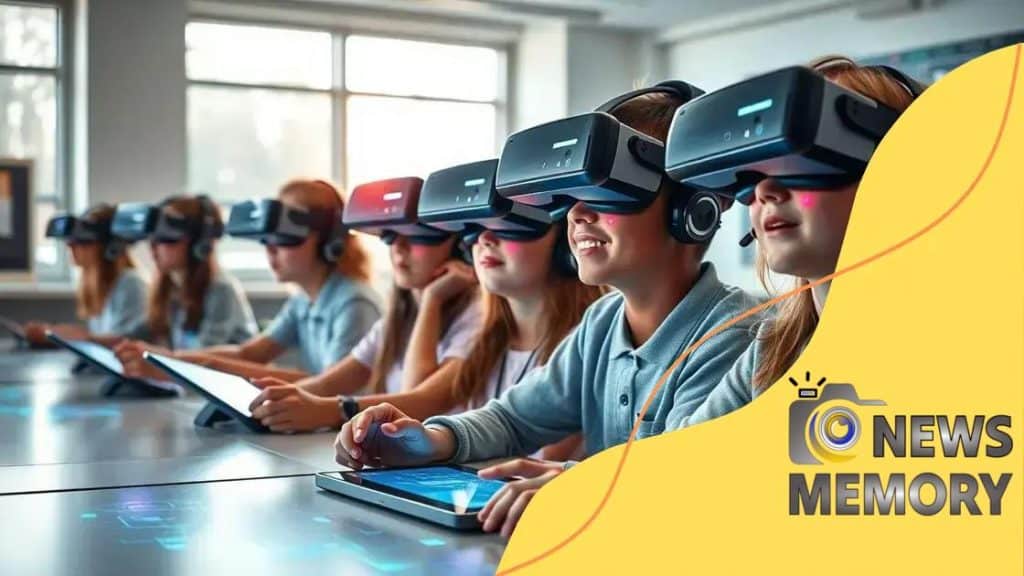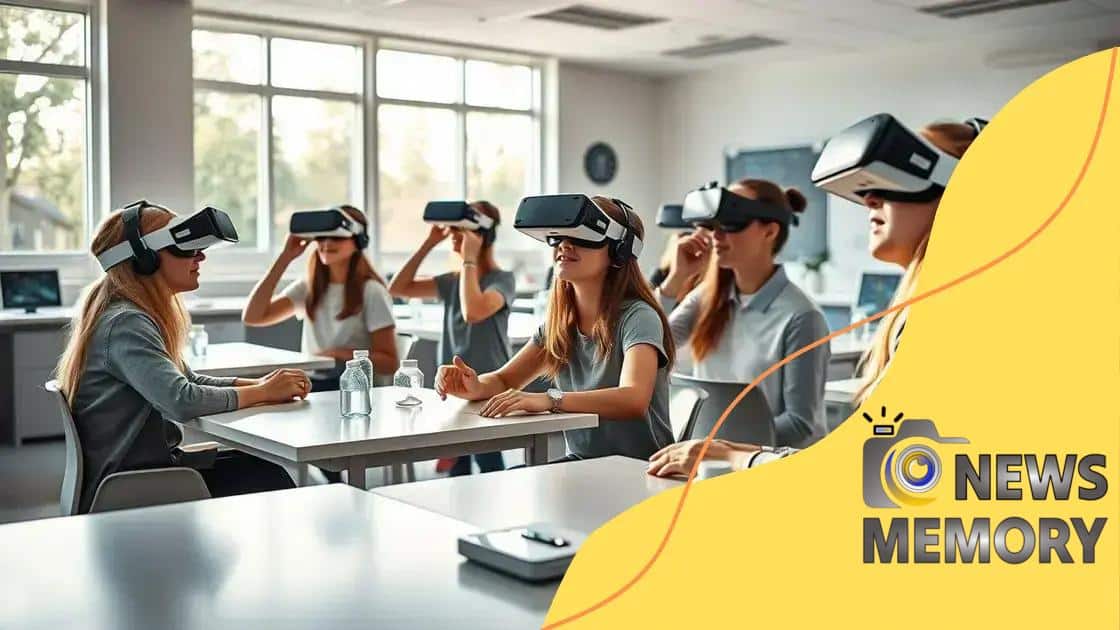The future of education with fully immersive virtual environments

The future of education with fully immersive virtual environments enhances learning through personalized experiences, increases collaboration among students, and leverages artificial intelligence for improved outcomes.
The future of education with fully immersive virtual environments invites us to rethink traditional learning. Imagine stepping into history or exploring science like never before! How do these technologies enhance our understanding and excitement for learning? Let’s explore.
Understanding immersive virtual environments
Understanding immersive virtual environments is essential as we explore their role in modern education. These environments use technology to create engaging, interactive spaces where learners can experience subjects in a hands-on way. Imagine stepping into a virtual world, where history comes alive or scientific concepts are visually represented.
What Are Immersive Virtual Environments?
Immersive virtual environments combine elements of virtual reality (VR), augmented reality (AR), and interactive simulations. They enable users to interact with 3D representations of information, making learning more engaging than traditional methods.
Benefits of Immersive Learning
This type of learning offers several benefits:
- Enhanced retention: Students remember information better when they can see and experience it.
- Interactive experience: Hands-on involvement promotes deeper understanding.
- Safe exploration: Students can experiment without real-world consequences.
- Accessibility: These environments can reach learners who are unable to participate in traditional education settings.
As technology progresses, more educators are recognizing the potential of immersive virtual environments. They create opportunities for collaborative projects where students can interact in a shared digital space. Learning becomes a community effort, breaking down barriers that often exist in physical classrooms.
Imagine a physics class where students conduct experiments in a simulated lab. They can manipulate variables in real-time, observing outcomes instantly. This approach enhances critical thinking and problem-solving skills.
Challenges and Considerations
Despite the exciting prospects, there are challenges. Access to technology remains a barrier for some students. Additionally, educators need training to effectively integrate these tools into their curriculum. Furthermore, creating high-quality immersive content requires substantial investment and expertise.
As we venture into the future of education, understanding immersive virtual environments will be crucial. They represent a shift towards a more engaging way of learning, offering students the chance to experience education in a whole new light.
Impact of immersive tech on learning outcomes
The impact of immersive technology on learning outcomes has been significant, revolutionizing how students absorb information. With tools like virtual reality (VR) and augmented reality (AR), learners engage in interactive experiences that deepen their understanding.
Enhancing Engagement
Immersive technology captures attention in ways that traditional methods cannot. When students wear VR headsets, they find themselves in simulated environments that stimulate curiosity and excitement. This enhanced engagement leads to a more profound interest in subjects.
Improving Retention
Research shows that immersive learning can boost information retention. When students participate in realistic simulations, they are likely to remember the material longer. Experiencing concepts first-hand allows them to connect theoretical knowledge with practical application.
- Active participation: Learners are more involved and less passive.
- Visual aids: VR provides powerful visual support for complex ideas.
- Experiential learning: Engaging directly with material leads to better comprehension.
Moreover, immersive tech supports diverse learning styles. Some students grasp concepts better through visuals, while others benefit from hands-on experiences. By leveraging technology, educators can cater to various needs, making learning more inclusive.
Furthermore, immersive environments often promote collaboration. Students can work together in a virtual space, solving problems collectively. This social interaction can enhance communication skills and foster teamwork.
Challenges to Consider
While the benefits are clear, challenges remain. Not all schools have access to cutting-edge technology, and the investment can be substantial. Additionally, teachers require proper training to maximize these tools’ effectiveness. Ensuring that immersive technology is integrated thoughtfully into curricula is vital for its success.
As we continue to explore the impact of immersive tech, it’s crucial to monitor its effectiveness. Learning outcomes can improve significantly when used correctly, paving the way for a more engaging and effective educational landscape.
Real-world applications in education

Real-world applications in education demonstrate how immersive technology enhances student learning beyond the classroom. By integrating tools like virtual reality (VR) and augmented reality (AR), educators create interactive experiences that connect theory with practice.
Field Trips in Virtual Reality
One prominent application is virtual field trips. Students can explore historical sites, museums, or natural wonders without leaving their classrooms. This engaging experience allows them to see the world from a new perspective.
- Accessibility: Every student can access locations that may be difficult or expensive to visit.
- Interactive learning: Engaging with real-world environments fosters curiosity and excitement.
- Diverse experiences: Students can explore different cultures and environments firsthand.
Moreover, AR can transform textbooks into interactive experiences. By scanning images, students can see 3D models that enhance their understanding. This fusion of technology and traditional learning materials helps students visualize complex concepts.
Simulations for Skill Development
Another significant application is the use of simulations in fields such as medicine, engineering, and aviation. Simulations allow students to practice skills in a safe environment. For example, medical students can perform surgeries in VR settings, gaining valuable experience without the risks associated with real patients.
In engineering, students can design and test structures using software that simulates real-world conditions. This hands-on practice builds confidence and mastery of important skills.
Furthermore, immersive technology can enhance soft skills, such as communication and teamwork. Group projects in virtual settings teach students to collaborate effectively, preparing them for future workplace environments.
Improving Learning Outcomes
As immersive technology becomes more integrated into education, the potential for improved learning outcomes expands. Students who engage with real-world applications tend to enjoy learning more. Their experiences become relevant to their everyday lives, making education not just about passing tests but about understanding the world around them.
In conclusion, the real-world applications of immersive technology in education are transformative. By incorporating these tools into the classroom, educators are offering students exciting opportunities to learn, explore, and prepare for their futures.
Challenges educators face with new technology
Challenges educators face with new technology can significantly affect its implementation in classrooms. While immersive technology offers many benefits, schools must navigate several hurdles to leverage these tools effectively.
Training and Support
One of the primary challenges is the need for proper training. Educators often feel overwhelmed when using new technologies. Without adequate professional development, teachers may struggle to integrate virtual reality and augmented reality into their lessons. This lack of support can lead to frustration and underutilization of valuable resources.
- Professional development: Regular training sessions are essential to build confidence.
- Peer collaboration: Teachers can learn from each other’s experiences with new technology.
- Access to resources: Schools need to provide access to materials and tools for effective integration.
Another challenge is budgeting for technology. Schools face tight budgets and must prioritize spending. Investing in immersive technology requires significant financial resources. Additionally, maintaining equipment can strain already limited funds. Educators often need to advocate for the inclusion of these technologies in their budgets, which can be a difficult battle.
Technological Barriers
Beyond funding, technological barriers can also hinder progress. Not all classrooms have reliable internet access, which is crucial for many immersive applications. This digital divide can create inequality in educational opportunities. Students without access to technology at home may fall behind their peers who can engage with these tools outside of school.
Moreover, some teachers encounter resistance from parents and administrators. They may question the value of incorporating immersive technologies into the curriculum. Educators need to communicate the benefits effectively and demonstrate how these tools enhance learning outcomes to gain support.
Curriculum Integration
Integrating new technology into existing curricula poses another challenge. Teachers must find ways to blend traditional teaching methods with immersive experiences. This process can be time-consuming and requires thoughtful planning. Educators need to develop strategies that align these technologies with learning objectives without overwhelming students.
As technology continues to advance, educators must remain adaptable. The landscape of education is changing rapidly, and it is crucial for teachers to stay informed about new tools and trends. Engaging with professional learning communities can provide valuable insights and foster a culture of collaboration.
Future trends in virtual learning
Future trends in virtual learning are emerging as technology continues to evolve. As educators and students embrace new tools, the landscape of education is transforming dramatically. With the growth of immersive technologies, learners will experience education in more engaging and interactive ways.
Personalized Learning Experiences
One significant trend is the rise of personalized learning. Virtual learning platforms can adapt to each student’s needs, providing customized resources and activities based on their performance. This individualized approach helps students learn at their own pace, making it easier to grasp complex concepts.
- Adaptive learning technology: Software that modifies content based on student progress.
- Tailored assessments: Tests that adjust difficulty according to skill level.
- Student-centered approaches: Empowering learners to take charge of their education.
As personalized learning becomes more commonplace, educators will need to develop their skills to utilize these technologies effectively. They will play a crucial role in guiding students through their customized learning paths.
Increased Collaboration
Another trend is the focus on collaboration in virtual settings. Online platforms are making it easier for students to work together, even from different locations. They can engage in group projects, share resources, and brainstorm ideas in real-time. This connectivity not only enhances teamwork skills but also prepares students for future workplaces.
Additionally, virtual reality can create shared experiences where students immerse themselves in the same environment, despite being physically apart. This shared learning experience can promote a sense of community and belonging among learners.
Integration of Artificial Intelligence
The integration of artificial intelligence (AI) into virtual learning platforms is another exciting trend. AI can provide instant feedback, helping students understand their mistakes quickly. AI-powered tutors can offer additional support outside traditional classroom hours, making learning more accessible.
Moreover, AI can analyze data to provide insights on student performance, helping educators refine their teaching strategies. By leveraging this technology, teachers can create more effective lesson plans and interventions tailored to their students’ unique needs.
As we look ahead, the future of virtual learning holds incredible potential. As these trends develop, educational experiences will become more immersive, collaborative, and tailored to individual needs. Embracing these changes will be vital for educators and students alike.
In conclusion, the future of education is bright with the emergence of fully immersive virtual environments. As we adopt this innovative technology, personalized learning experiences will become more accessible to everyone. Collaboration and communication among students will thrive in virtual settings, preparing them for the challenges of the future. By embracing trends like artificial intelligence, educators can enhance teaching methods and provide real-time feedback. Overall, immersive technology offers exciting opportunities that can transform the learning landscape for students and teachers alike.
FAQ – Frequently Asked Questions About Immersive Virtual Learning
What are the benefits of immersive virtual environments in education?
Immersive virtual environments engage students in interactive learning, enhancing their understanding and retention of information while making learning more enjoyable.
How does personalized learning work with virtual education?
Personalized learning tailors educational experiences to meet each student’s needs, allowing them to progress at their own pace with resources suited to their skills.
What role does artificial intelligence play in future learning?
Artificial intelligence provides instant feedback, helps track student performance, and offers additional tutoring outside regular classroom hours.
How can educators overcome challenges with new technology?
Educators can overcome challenges by seeking professional development, collaborating with peers, and advocating for necessary resources to enhance their teaching.





